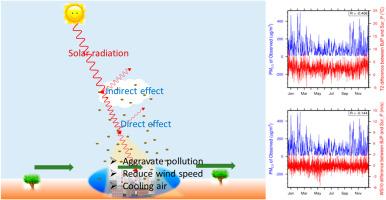Anthropogenic aerosol feedbacks intensify air pollution and weather variability over China
IF 3.7
2区 环境科学与生态学
Q2 ENVIRONMENTAL SCIENCES
引用次数: 0
Abstract
Aerosols from human activities significantly affect the radiative balance and energy equilibrium of the atmosphere, thereby influencing air pollutant concentrations and meteorological factors. This study examines the Chinese mainland and its surrounding regions in 2014, revealing that aerosols influence meteorological factors and therefore the pollutant concentrations, especially in areas experiencing severe particulate pollution. The aerosol feedback not only increases the annual average concentration of pollutants such as PM2.5 (0.30 μg m−3) and CO (4.04 ppbV), but also reduces the annual average values of meteorological variables such as surface temperature (0.18 K) and wind speed (0.01 m s−1). The magnitude of aerosol feedback on pollutants and meteorological factors depends primarily on the mass concentration of aerosols. During the 2014 Asia-Pacific Economic Cooperation (APEC) Summit in Beijing emission reduction period, the impact of aerosol feedback on pollutants and meteorology was clearly weakened in the key emission reduction areas, reflecting the influence of aerosol feedback. Importantly, the feedback effects of aerosols in heavily polluted areas is up to an order of magnitude greater than in the broader study region, although with large spatial variability. In the heavily polluted areas like Beijing, PM2.5 concentrations correlate well with the difference of temperature and wind speed between Beijing and its surrounding areas. It is also shown that, in case of heavy pollution, WRF-Chem model predictive capabilities often diminish, presenting underestimation and shortcomings in assessing the impact of aerosols on heavy pollution and regional disparities. This implies that some feedback processes involving anthropogenic aerosols may not be fully represented in the model. In the face of increasingly severe climate change, better understanding of the bidirectional interactions between aerosols and meteorology, along with associated feedback mechanisms, is essential for effectively mitigating air pollution, adapting to climate change, and managing climate impacts. This study highlights the critical role of aerosol feedback in regional pollution and modulating meteorological factors, providing a scientific basis for targeted air quality management and climate mitigation strategies in heavily polluted areas.

人为气溶胶反馈加剧了中国的空气污染和天气变率
人类活动产生的气溶胶显著影响大气的辐射平衡和能量平衡,从而影响大气污染物浓度和气象因子。本研究考察了2014年中国大陆及其周边地区,揭示了气溶胶影响气象因子,从而影响污染物浓度,特别是在颗粒物污染严重的地区。气溶胶反馈不仅增加了PM2.5 (0.30 μg m−3)和CO (4.04 ppbV)等污染物的年平均浓度,而且降低了地表温度(0.18 K)和风速(0.01 m s−1)等气象变量的年平均值。气溶胶对污染物和气象因子的反馈大小主要取决于气溶胶的质量浓度。2014年亚太经合组织(APEC)北京峰会减排期间,重点减排区域气溶胶反馈对污染物和气象的影响明显减弱,反映了气溶胶反馈的影响。重要的是,在严重污染地区,气溶胶的反馈效应比更广泛的研究区域要大一个数量级,尽管具有较大的空间变异性。在像北京这样的重污染地区,PM2.5浓度与北京和周边地区的温度和风速差异有很好的相关性。研究还表明,在重污染情况下,WRF-Chem模型的预测能力往往下降,在评估气溶胶对重污染的影响和区域差异方面存在低估和不足。这意味着一些涉及人为气溶胶的反馈过程可能没有在模式中得到充分体现。面对日益严重的气候变化,更好地了解气溶胶与气象之间的双向相互作用,以及相关的反馈机制,对于有效减轻空气污染、适应气候变化和管理气候影响至关重要。该研究突出了气溶胶反馈在区域污染和气象因子调节中的关键作用,为重污染地区有针对性的空气质量管理和气候减缓策略提供了科学依据。
本文章由计算机程序翻译,如有差异,请以英文原文为准。
求助全文
约1分钟内获得全文
求助全文
来源期刊

Atmospheric Environment
环境科学-环境科学
CiteScore
9.40
自引率
8.00%
发文量
458
审稿时长
53 days
期刊介绍:
Atmospheric Environment has an open access mirror journal Atmospheric Environment: X, sharing the same aims and scope, editorial team, submission system and rigorous peer review.
Atmospheric Environment is the international journal for scientists in different disciplines related to atmospheric composition and its impacts. The journal publishes scientific articles with atmospheric relevance of emissions and depositions of gaseous and particulate compounds, chemical processes and physical effects in the atmosphere, as well as impacts of the changing atmospheric composition on human health, air quality, climate change, and ecosystems.
 求助内容:
求助内容: 应助结果提醒方式:
应助结果提醒方式:


